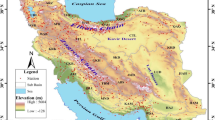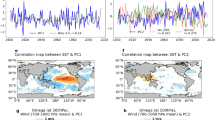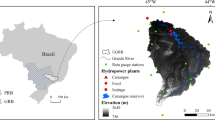Abstract
The drought that occurred in 2014/2015 over the Metropolitan Region of São Paulo (MRSP) was considered one of the most intense in the region’s history, causing a crisis in the state of São Paulo’s public water-supply sector. The objectives of this study were: (1) to generate a hydroclimatological baseline for the Cantareira System region; (2) to evaluate the local potential relationship between teleconnections based on global climatic indices and rainfall/flow anomalies; and (3) to propose a tool to assist in the management of the MRSP’s largest water-production system. Precipitation and natural-flow data in the Cantareira System for 1948–2015 were used in this study. The evaluated teleconnection indices included the Oceanic Niño Index (ONI), Antarctic Oscillation (AAO), Pacific Decadal Oscillation (PDO), Atlantic Multidecadal Oscillation (AMO) and North Atlantic Oscillation (NAO). We verified that these indices were more sensitive on a seasonal scale to the occurrence of excess rainfall and flow events than drought events. For the ONI and AAO positive phases, the Cantareira System’s flow was above-average in summer and winter, which is associated with flood events. The AAO’s negative phase was associated with deficit events in summer and winter, but not extreme deficit events. The PDO’s positive phase was associated with flood events in winter and spring. The results from this study could be used as an additional climatic tool for managing the Cantareira System through the monitoring of average flows and seasonal indices.




Similar content being viewed by others
References
ANA, DAEE (2016) Dados de Referência Acerca da Outorga do Sistema Cantareira. Agência Nacional de Águas. Departamento de Águas e Energia Elétrica. São Paulo. Available at: http://www2.sabesp.com.br/mananciais/dadoscantareira/DDR_Sistema_Cantareira-Anexo2.pdf. Accessed 1 Dec 2017
Andreoli RV, Kayano MT (2005) ENSO-related rainfall anomalies in South America and associated circulation features during warm and cold Pacific decadal oscillation regimes. Int J Climatol 25:2017–2030
Anji S, Fernandes K, Camargo SJ (2015) Two summers of São Paulo drought: origins in the western tropical Pacific Geophys. Res Lett 42:10816–10823
Bernardino BS, Vasconcellos FC, Nunes AM (2018) Impact of the equatorial Pacific and South Atlantic SST anomalies on extremes in austral summer precipitation over Grande river basin in Southeast Brazil. Int J Climatol 38(Suppl.1):e131–e143
Cabrera VE, Solís D, Baigorria A, Letson D (2009) Managing climate variability in agricultural analysis. In: Long JA, Wells DS (eds) Ocean circulation and El Niño: new research. Nova Science Publishers, Inc, Hauppauge, pp 163–179
Carvalho L, Jones C, Liebman B (2004) The South Atlantic convergence zone: intensity, form, persistence, and relationship with intraseasonal to interanual activity and extreme rainfall. J. Clim 17:88–108
Cavalcanti IFA, Ferreir NJ, Silva MGAJ, Dias MAFS (Org). (2009) Tempo e clima no Brasil. Oficina de Textos, São Paulo, p 260–275
Chiessi CM, Mulitza S, Pätzold J, Wefer G, Marengo JA (2009) Possible impact of the Atlantic multidecadal oscillation on the South American summer monsoon. Geophys Res Lett 36:L21707. https://doi.org/10.1029/2009GL039914
Coelho CAS, Cardoso D, Firpo M (2015a) Precipitation diagnostics of an exceptionally dry event in Sao Paulo. Brazil. Theor and App Clim 125:769–784
Coelho CAS, Oliveira C, Ambrizi T, Reboita M, Carpenedo C, Campos J, Tomaziello A, Pampuch L, Custodio MS, Dutra L, Da Rocha R, Rehbein A (2015b) The 2014 Southeast Brazil austral summer drought: regional scale mechanisms and teleconnections. Clim Dynam 46:3737–3752
Coelho CAS, Firpo MAF, Maia HN, Maclachlan G (2017) Exploring the feasibility of empirical, dynamical and combined probabilistic rainy season onset forecasts for São Paulo. Brazil Int J Climatol 37:1–10. https://doi.org/10.1002/joc.5010
Cunningham CC, Cavalcanti IF (2006) Intraseasonal modes of variability affecting the South Atlantic convergence zone. Int J Climatol 26:1165–1180
Friederike EL et al (2015) Factors other than climate change, main drivers of 2014/15 water shortage in Southeast Brazil [in “explaining extremes of 2014 from a climate perspective”]. Bull Amer Meteor Soc 96(12):S35–S40
FABHAT - Fundação Agência da Bacia Hidrográfica do Alto Tietê (2014) Relatório de Situação dos Recursos Hídricos: Bacia Hidrográfica do Alto Tietê - UGRHI 06 - Ano Base 2013. São Paulo. Available at: <http://www.sigrh.sp.gov.br/public/uploads/documents//CBH-AT/12322/ relatorio_situacao_dos_recursos_hidricos_ugrhi_06_2017.pdf>. Accessed: February 25, 2018
Hurrell JW, Kushnir Y, Ottersen G, Visbeck M (2003) An overview of the North Atlantic Oscillation. In: Hurrell JW, Kushnir Y, Ottersen G, Visbeck M (eds) The North Atlantic Oscillation. Climate Significance and Environmental Impact, Geophysical Monograph Series, 134. American Geophysical Union, Washington, DC, p 1–35
IPCC (2013) Annex III: glossary [Planton, S. (ed.)]. In: Stocker TF, Qin D, Plattner G-K, Tignor M, Allen SK, Boschung J, Nauels A, Xia Y, Bex V, Midgley PM (eds) Climate change 2013: the physical science basis. Contribution of working group I to the fifth assessment report of the intergovernmental panel on climate change. Cambridge University Press, Cambridge and New York
Kayano MT, Andreoli RV (2006) Relationships between rainfall anomalies over Northeastern Brazil and El Niño/Southern Oscillation. J Geophys Res, Washington, DC, EUA 111:D13101
Kayano MT, Capistrano VB (2014) How the Atlantic multidecadal oscillation (AMO) modifies the ENSO influence on the south American rainfall. Int J Climatol 34:162–178
Kendall MG (1975) Rank correlation measures. London, U.K, Charles Griffin, 220 p
Mann HB (1945) Econometrica. Econ Soc 13(3):245–259
Mantua NJ, Hare SR (2002) The Pacific decadal oscillation. J Oceanogr 58(1):35–44
Martinez CJ, Baigorria GA, Jones JW (2009) Use of climate indices to predict corn yields in Southeast USA. Int J Climatol 29(11):1680–1691. https://doi.org/10.1002/joc.1817
Milano M, Reynard E, Muniz-Miranda G, Guerin J (2018) Water supply basins of São Paulo metropolitan region: hydro-climatic characteristics of the 2013–2015 water crisis. Water 10:1517
Millington N (2018) Producing water scarcity in São Paulo, Brazil: The 2014–2015 water crisis and the binding politics of infrastructure. Polit. Geogr, pg 26–34
Moraes JM, Pellegrino GQ, Ballester MV, Martinelli LA, Victoria RL, Krusche AV (1998) Trends in hydrological parameters of a southern brazilian watershed and its relation to human induced changes. Water Resourc Manag 12(295):311
Nam WH, Baigorria GA (2015) Analyzing changes to the spatial structures of precipitation and temperature under different ENSO phases in the Southeast and Midwest United States. Meteorol. Appl 22(4):797–805
National Oceanic and Atmospheric Administration – NOAA (2016) Climate Indices: Monthly Atmospheric and Ocean Time Series. EUA. Available at: https://www.esrl.noaa.gov/psd/data/ climateindices/. Accessed: May 20, 2016
Nobre CA, Marengo JA, Seluchi ME, Cuartas LA, Alves LM (2016) Some characteristics and impacts of the drought and water crisis in southeastern Brazil during 2014 and 2015. J Water Resource Prot 8:252–262 Available at: https://doi.org/10.4236/jwarp.2016.82022
Prado LF, Waimer I (2013) Planetary-scale climatic indices and relationship between decadal variability of rainfall in northeastern and southern Brazil. Rev Bras Geofís 31(1):31–41
Rosso FV, Boiask NT, Ferraz ET (2018) Influence of the Antartic oscillation on the South Atlantic convergence zone. Atmosphere 9:431
SABESP (2015) Companhia de Saneamento Básico do Estado de São Paulo. Complexo Metropolitano. Available at: http://site.sabesp.com.br/site/interna/Default.aspx?secaoId=36. Accessed 10 July 2015
Salmi T, Maatta A, Anttila P, Ruoho-Airola T, Amnell T (2002) Detecting trends of annual values of atmospheric pollutants by the Mann-Kendall test and Sen’s slope estimates-the excel template application Makesens. Finnish Meteorological Institute publications on air quality no. 31, Helsinki, Finland
Satyamurty P, Nobre CA, Dias PLS (1998) Tropics - South America. In: D. J. Karoly; D. G. Vincent. (Org.). Meteorology of the Southern Hemisphere. Boston: meteorology monograph, v. 49, p. 119-139
Sentas A, Psilovikos A, Psilovikos T (2016) Statistical analysis and assessment of water quality parameters in Pagoneri. River Nestos European Water 55:115–124
Shin DW, Baigorria GA (2012) Potential influence of land development patterns on regional climate: a summer case study in Central Florida. Nat Hazards 62(3):877–885
Targa MS, Batista GT (2015) Benefits and legacy of the water crisis in Brazil. Rev. Ambient. Água vol. 10 n. 2 Taubaté – Apr. / Jun.
Valverde MC, Marengo JA (2014) Extreme rainfall indices in the hydrographic basins of Brazil. Open J of Modern Hydrol 4(1):10–26
Vasconcellos FC, Cavalcanti IF (2010) Extreme precipitation over Southeastern Brazil in the austral summer and relations with the Southern Hemisphere annular mode. Atmos Sci Let 11:21–26
Author information
Authors and Affiliations
Corresponding author
Ethics declarations
Conflict of Interest
The authors declare that they have no conflict of interest.
Additional information
Publisher’s Note
Springer Nature remains neutral with regard to jurisdictional claims in published maps and institutional affiliations.
Rights and permissions
About this article
Cite this article
Calado, G.G., Valverde, M.C. & Baigorria, G.A. Use of Teleconnection Indices for Water Management in the Cantareira System - São Paulo – Brazil. Environ. Process. 6, 413–431 (2019). https://doi.org/10.1007/s40710-019-00368-9
Received:
Accepted:
Published:
Issue Date:
DOI: https://doi.org/10.1007/s40710-019-00368-9




